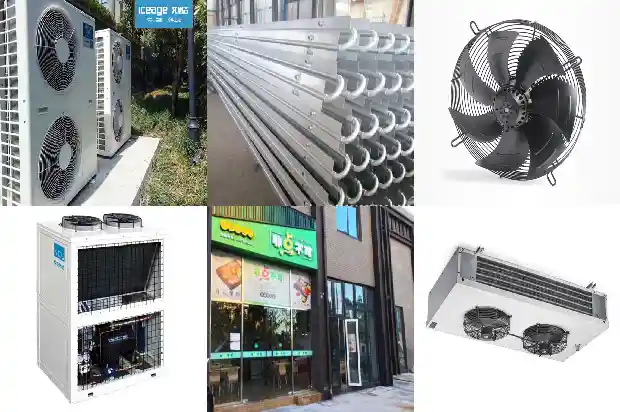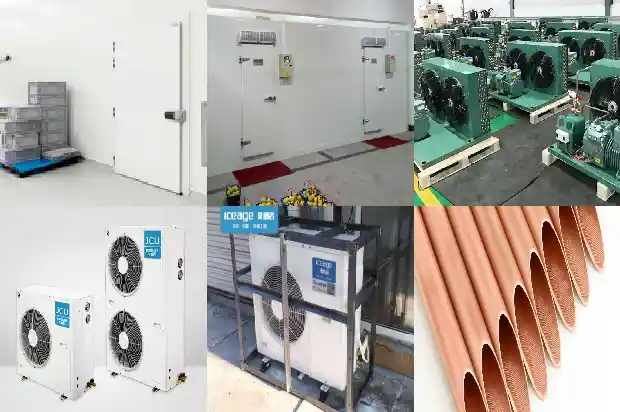Which is Better: Ammonia Refrigeration or Fluorine Refrigeration?
2025-01-07
In the refrigeration industry, ammonia refrigeration and fluorine refrigeration have always been the focus of debate. The key issue is which refrigeration method can maximize economic, environmental, and social benefits.
- Comparison of the properties of ammonia refrigerant (R717) and fluorine refrigerants (R22 and R404A)
Safety: The explosiveness and toxicity of ammonia greatly limit its application. In recent years, with the frequent occurrence of problems in ammonia refrigeration systems, people have developed a certain degree of fear of ammonia refrigeration systems. The high safety of fluorine refrigerants is the main reason for the rapid development of fluorine refrigeration systems in recent years.
Environmental friendliness: The ODP (Ozone Depletion Potential) of ammonia is zero, and its GWP (Global Warming Potential) is also zero. R404A is a refrigerant that is relatively friendly to the environment. However, due to its poor environmental performance, the application of R22 refrigerant will be restricted in developing countries before 2020. Currently, industry insiders are actively seeking environmentally friendly alternative refrigerants.
Material compatibility: When ammonia contains moisture, it is corrosive to copper. Therefore, copper and copper alloys cannot be used for the pipes and valves of ammonia systems, which brings certain limitations in the selection of system device materials. The chemical stability and thermal stability of fluorine refrigerants are very high, and theoretically, they are not corrosive to all metals.
Interaction with water: The allowable water content of ammonia is below 0.2%. Since ammonia is highly soluble in water, even if there is a trace amount of water, it will not cause "ice plugging" like Freon. Therefore, the drying requirements for the pipeline system of the ammonia refrigeration system are not as strict as those for Freon. Freon is hardly soluble in water. Therefore, if there is water in the system, it is likely to cause ice plugging. Usually, a drying filter is installed in the system.
Interaction with oil: Currently, the lubricating oil used in ammonia refrigeration systems is mineral oil, which is immiscible with ammonia. Usually, equipment such as oil separators and oil collectors are installed. The lubricating oil is returned to the compressor through automatic or manual control. R404A is immiscible with mineral oil and alkylbenzene oil but can be mixed with polyester oil (POE). However, at high temperatures (around 50°C), there is a phenomenon of immiscible stratification. At the same time, R22 is slightly soluble in lubricating oil. Therefore, large - scale fluorine refrigeration systems usually also install equipment such as oil separators and oil storage devices. Taking R404A as an example, the only difference between these two compressors is the refrigerant. The refrigeration capacities of R717, R22, and R404A were compared under the same evaporation temperature (- 10°C), condensation temperature (45°C), liquid sub - cooling degree (0K), and suction superheat (10K). Ammonia has more advantages than fluorine in terms of refrigeration capacity, COP (Coefficient of Performance), and mass flow rate. However, the exhaust temperature of R717 is much higher than that of R22 and R404A, which increases the requirements for the configuration of system components. The refrigeration capacity per unit mass of ammonia is much larger than that of fluorine, indicating that ammonia has better refrigeration capacity. However, when the evaporation temperature reaches - 33.33°C, the gauge pressure of ammonia is 0. To avoid the system operating under negative pressure, ammonia is generally mainly used in systems with an evaporation temperature above - 33.33°C.
- System complexity
Ammonia refrigeration is a pump - fed liquid system. Since the mineral lubricating oil used in the ammonia refrigeration system is immiscible with ammonia, equipment such as oil separators and oil collectors are indispensable in the ammonia system to ensure oil return and reduce the system temperature, making the oil circuit system of the ammonia system very complex. This makes the ammonia system large - scale, with many auxiliary machines, complex pipelines, many valves, complex construction, and a long construction period. The fluorine system has a compact structure, occupies a small area, has few accessories, and the unit configuration is already very complete. Most of the work can be completed in the factory of the unit supplier. - Equipment investment
The ammonia system includes many equipment, mainly including compressors, evaporators, condensers, oil separators, high - and low - pressure liquid storage barrels, intermediate coolers, re - coolers, ammonia liquid separators, low - pressure circulation barrels, emergency ammonia release devices, air vents, oil collectors, ammonia pumps, and corresponding valves and bypass valves, resulting in a large amount of on - site installation work. The main equipment included in the fluorine system includes compressors, evaporators, condensers, oil separators, oil collectors, gas - liquid separators, liquid storage devices, and corresponding valves, etc. Generally, the fluorine system uses copper pipes or steel pipes, which are convenient to connect and have a simple pipe layout, and the amount of pipelines used is less than that of the ammonia system. Regarding the investment costs of ammonia and fluorine refrigeration equipment, at the same equipment quality and control method level, for small - scale cold storage (compressors less than 50Hp), the equipment price of fluorine is more than 10% lower than that of ammonia. For medium - and large - scale cold storage, the prices are almost the same. If imported or domestically assembled fluorine refrigeration equipment with imported components is used, it is more than 30% cheaper than imported ammonia refrigeration equipment, but 20% - 30% more expensive than domestic ammonia refrigeration equipment. - Degree of automation
Due to factors such as the material of the valves, processing equipment, and processing technology of domestic ammonia systems, the valve leakage problem in ammonia systems is serious, making it difficult to achieve a high degree of automatic control.
Special personnel are required to manage it 24 hours a day (Note: There are also automated ammonia storage facilities now, but they are relatively few). Since the components of the fluorine system are mature in product and stable in performance, it is easy to achieve highly integrated and relatively stable automatic control, and the system can basically operate unattended. Due to the harm of Freon refrigerants to the atmospheric environment, the use of fluorine refrigeration has been restricted to a certain extent in recent years. Therefore, actively seeking a more ideal refrigerant is the development direction of fluorine refrigeration. Positive progress has been made in the search for Freon substitute refrigerants. Some experts and scholars have pointed out that better refrigerants to replace R22 are R407C, R410A, and R32, etc.
- Conclusion
The advantages and disadvantages of ammonia and fluorine refrigerants were analyzed and compared from the aspects of refrigerant properties and current application characteristics. It shows that ammonia refrigeration has good refrigeration performance, but the toxicity and danger of ammonia must be considered. Therefore, we need to continuously study and improve the objectively existing problems of the ammonia refrigeration system. The good safety and simplicity of fluorine refrigeration are widely applied in small - and medium - scale cold storage, and there is also a trend of development towards large - scale in the current situation. However, the harm of Freon to the atmospheric environment cannot be ignored. Therefore, finding a more ideal refrigerant remains the focus and direction of future research.
Related Articles
- Where Lie the Key Construction Technologies of the Ammonia Refrigeration System?
- How to Properly Extract Ammonia Refrigerant during Refrigeration Parts Repair
- Cooling Operation of Ammonia Refrigerated Cold Storage
- Scheme for the Use and Safety of Ammonia Refrigerants
- Safety Regulations for Ammonia Refrigeration Machine Room
- Cost Comparison of Ammonia-to-Fluorine Conversion in Cold Storage Renovation
- What is the difference between ammonia refrigeration and fluorine refrigeration?
- Have You Encountered the Three Common Problems of Refrigeration Compressors?
- How to Calculate Refrigeration Load? And What Are the Issues?
- What to Do if the Compressor of a Frozen and Refrigerated Display Cabinet Runs but the Refrigeration Effect Is Poor?
- Instructions for Welding and Drainage in the Installation of Refrigeration Equipment Pipelines
- Common Pressure Valves and Protection Devices in Refrigeration Units
- Precautions for Using Rotary Refrigeration Compressors
- What Misconceptions Should Be Avoided in Low - temperature Refrigeration System Repairs
- Essential for Maintenance! Parameters and Phenomena of Normal Operation of Refrigeration and Heating Systems
- Composition and Common Faults of Screw Refrigeration Compressors
- How to Read the High - and Low - Pressure Gauges of Refrigeration Air - conditioners?
- What is Cascade Refrigeration?
